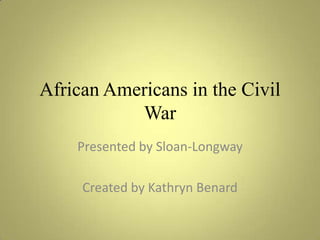
African Americans In The Civil War
- 1. African Americans in the Civil War Presented by Sloan-Longway Created by Kathryn Benard
- 2. Why is it important to study African American involvement in the Civil War? Do you think African Americans fighting in battle was controversial? Why or why not?
- 3. African Americans in the War Approximately 180,000 African Americans in 163 units served in Union forces (both Army and Navy) during the Civil War Free blacks and runaway slaves comprised these numbers Photo Courtesy of the Library of Congress
- 4. African Americans in War, continued The Emancipation Proclamation helped pave the way for African Americans to be able to enlist in the Union Army Until then federal law prohibited them from enlisting since 1792 (now 1862). Even though they bravely went off to war, African American soldiers faced many difficulties with racial prejudice. Many times the black soldiers were assigned to non-combat positions such as cooks. Black soldiers were paid $10 a month with an automatic $3 deduction for clothing. White soldiers were paid $13 a month, with no clothing deduction Of the 180,000 black soldiers, about 40,000 died during the war. About 30,000 of them from disease. Black women also played a role in the war, although they could not join the army. They served as nurses, spies, etc.
- 5. Harriet Tubman Born as Araminta Ross, around 1820 later changing her name to Harriet, after her mother Was a Maryland slave, working in the master’s home as a servant. As a teenager attempted to defend a field hand and was injured. She was hit in the head. She would suffer from instances of falling into a very deep sleep from that point on. Married a free black in 1844 named John Tubman, taking his last name. Due to the fear of the plantation being sold, she ran away from the plantation. She followed the North Star making her way to Philadelphia She found work and saved her money. She would return to Maryland and escort other slaves and relatives to freedom. On her third trip, she went to get her husband only to find he had a new wife. She would make 19 trips, and would be nicknamed “Moses” for leading others to freedom. Became an active abolitionist. During the war Tubman also worked as a cook, nurse, and spy for the Union. Harriet Tubman died in 1913. Photo Courtesy of www.pbs.org
- 6. Frederick Douglass Was the son of a slave woman and an unknown white man Was born as Frederick Augustus Washington Bailey in 1818 in Maryland Grew up with his grandparents, only seeing his mother a handful of times in her lifetime (she died when he was 7) Witnessed the brutalities of slavery When he was eight he was sent to Baltimore to live with a ship carpenter There he learned to read and learned about abolition Seven years later he was sent back to live in the country and was hired out to a farm. He was whipped on a daily basis and barely was fed. He planned an escape but was jailed after it was learned about Was able to escape to New York a few years later. Settled in Massachusetts with his new wife and his new name, Frederick Douglass. Became a well known abolitionist and advocate for women’s rights. Photo Courtesy of www.pbs.org
- 7. 102nd Regiment- Michigan African American Infantry unit of the Union Army Originally known as the 1st Michigan Colored Volunteer Infantry Regiment Organized at Camp Ward, on a farm (Detroit area). 845 men from Detroit, southern Michigan, and Ontario volunteered, some of which were escaped slaves. They formed a band to tour and recruit more volunteers. Had some major successes in proving their ability to fight just as well as white troops. More than 1,400 men would join this regiment. Only 6 died in combat, 5 later died from wounds, and 129 died from disease. Photo courtesy of www.factasy.com
- 8. References 1st Regiment Michigan Volunteer Infantry (colored) (n.d.) Retrieved March 31, 2010 from http://www.michiganinthewar.org/infantry/1stcol.htm 102nd Regiment United States Colored Troops (n.d.) Retrieved March 31, 2010 from http://en.wikipedia.org/wiki/102nd_Regiment_United_States_Colored_Troops African Soldiers in War (n.d.) Retrieved March 31, 2010 from www.learnnc.org/lp/editions/nchist-civilwar/4.9 African Americans in the Civil War (n.d.) Retrieved March 31, 2010 from http://cwar.nps.gov/civilwar/africanamericans.htm Civil War and Reconstruction (n.d.) Retrieved March 31, 2010 from http://www.archives.gov/education/lessons/blacks-civil-war/ Colored Troops (n.d.) Retrieved March 31, 2010 from http://www.factasy.com/civil_war/files/u1/black_troops.gif Frederick Douglass (n.d.) Retrieved March 31, 2010 from http://www.pbs.org/wgbh/aia/part4/4p1539.html Harriet Tubman (n.d.) Retrieved March 31, 2010 from http://www.pbs.org/wgbh/aia/part4/4p1535.html